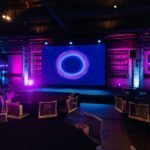What makes a good conference venue? Choosing the right room for your event involves many decisions, which can have a major impact on the final experience. The right room choice is the first and most crucial step in determining the overall aesthetic of your environment. While wall color and flooring are important, the infrastructure of the room plays a considerable role too. You must consider the following components when choosing the right space for your event.
Aesthetic
Your first decisions will focus on the size and overall feel of the room. Naturally, you will look at venues that accommodate the number of guests at your event. Even in the preliminary stages, each event has a target number of attendees and, just as important, the style of seating desired for your guests.
Will your guests be seated at round tables, high cocktail tables, in classroom style with a table in front, theater style or even chevron? This will determine the capacity of the room. Using a simple, free software such as social tables can let you double check that the room dimensions will suffice the style seating and number of guests you are planning for. After you know the number of guests, you can narrow your search to the venues that accommodate that number.
Now the choices get interesting. Venues seem to come in two major varieties. Some spaces have a unique, defined style; others are designed as blank canvases. You’ll choose the one that best fits the feel you are looking for, but something else to consider is the amount of natural light in the space.
Are there windows letting in fresh sunlight during your day time conference? Connecting with the outside can allow for a stuffy conference room to feel open and inviting. But consider what impact that can have on the video support. Outside light, also called ambient light, can have the byproduct of washing out projection screens if the projectors are not bright enough for the room. This can be overcome by either allowing for a bright projector in the budget or looking at LED TV’s that aren’t as impacted by the ambient light to ensure that the presentations and videos are easily viewed by your audience. A distorted effect may also occur because of wall sconces and room lighting. Depending on the shape and orientation of the room, a ceiling fixture or wall sconce can shine directly on a projection screen. You’ll want to ask about window coverings and lighting controls before committing to a venue.
Infrastructure
The Network
Depending on the format of your event, networking may be a priority for you. One of your keynotes may be presenting from another location such as their home or office. You may be planning on streaming your event to a paid website, or you may want to allow guests to post to social media. All of these considerations require that the venue have a reliable internet connection.
You don’t need to be an IT guru, but you do need to ensure that the internet connection has a large enough pipe to allow for your event to go off without a hitch. This guards against any interruptions to the connection with your remote presenter or remote audience. Your production partner can help advise on what is needed here and even spearhead the discussion with the venue on your behalf.
Power
Is there enough power in the space to accommodate the look and feel you are aiming for? Having a series of wall outlets can be handy for certain, smaller events, but once you start putting too many devices on the same circuit, the breaker will flip just like at home when the microwave, blender, and coffee maker are running simultaneously in your kitchen. In some cases your production partner will ask if there is a panel or three phase power that can be “tied in-to.” The amount of power needed to operate multiple projectors, stage lighting, audio speakers, and the other infrastructure to run the event can be too much for the wall outlets of a space. This is when a more substantial system is required with enough power and the right connections to properly power all of the equipment supporting the event. Again, your production partner can assist with this, but it is important to know that more consideration is needed when approaching power than just “are there enough outlets?”
Entrances, Exits, Catering
An important aspect of any event is how your guests will enter and exit the room, make their way to the restrooms, or find their way to the lunch buffet, among other scenarios. Try to visualize this flow when you’re visiting the venues and determine how these egress points play into deciding if a space is the right fit. If the only guest entrance crosses the path the catering team uses to serve, this could have a real negative impact on the flow of the room.
Existing AV
You may find that some venues have an installed AV system, which could include components essential for high-quality video production. This may lead you to see the system as an easy way to help minimize the budget. In some cases, a professionally installed system can be a true aid to your audio visual production partner, allowing for better viewing angles for video presentations or audio coverage because the speakers are installed in areas otherwise unreachable by a temporary setup. In other cases, these installed systems really only serve one layout in the space, which may not be in line with your plans.
It is important to consider the current system’s quality and how well-serviced the equipment has been. For example, you can count on a production company to take care of their equipment and ensure projector lamps are new and bright as they are experts in their craft and invested in the upkeep of the company’s investments. In other cases, the installed system may serve one type of event, such as a wedding, and may not serve something like a gala or conference based on the system design. This is where a temporary production setup can be more ideal because it serves your event specifically and ensures a high-quality experience.
Final Decision – More than Just the Physical Attributes
Room Availability
Another thing to consider when selecting a space is the availability. Checking to make sure that the space is available the day before and following the event ensures that all of your vendors have ample time to preset the room for the event. For your production partner, this means having the ability to test and run technical and speaker rehearsals prior to the event day. Not only does this give everyone peace of mind but seeing how the design and system works within the space can fine tune your show flow and presenter experience. Likewise, ensuring that each vendor has ample time to safely strike or clean up their equipment from the room ensures you’ll have a good working relationship with the venue and allow the vendors to keep their teams safe. This can have an impact on the overall budget by allocating additional days for the event, but it is both more efficient and produces a higher-quality event as you’re not fighting time crunches or last-minute emergencies.
The Bottom Line
Many of the outlined topics can have an impact on the event budget. Ultimately, we’re all responsible for budgets. But you have to remember that in some cases, the extra expense ensures that the longevity of your event is intact. Cutting corners could result in an event your attendees won’t return to in the future. Looking at the event holistically and putting into perspective the impact a negative guest experience can have helps us all realize how important it is to prioritize the planning stages. There are nuances that the specialists and vendors you employ can help guide you through. Understanding that selecting a room is only the first of many decisions, is the first step in setting your event up well. With this knowledge, you will avoid costly changes down the road, and give your guests the best experience possible by allowing them to focus on the presenters’ content. Let the space amplify those moments into something truly memorable.


